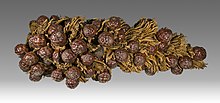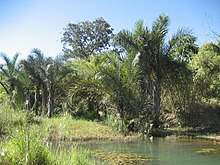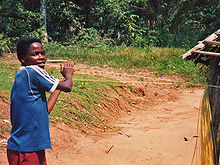Raphia
| Raphia | ||||||||||||
|---|---|---|---|---|---|---|---|---|---|---|---|---|

|
||||||||||||
| Systematics | ||||||||||||
|
||||||||||||
| Scientific name of the sub-tribus | ||||||||||||
| Raphiinae | ||||||||||||
| H. Wendl. | ||||||||||||
| Scientific name of the genus | ||||||||||||
| Raphia | ||||||||||||
| P.Beauv. |
Raphia is a genus of the palm family (Arecaceae). The species are primarily native to tropical Africa. The leaves of Raphia regalis are up to 25 m long and are the largest in the plant kingdom .
features
The representatives are mighty, trunkless or tree-shaped palms. The trunks stand individually or in groups and are reinforced. The palms are monoecious and bloom only once ( hapaxanth ).
The number of chromosomes is 2n = 28.
leaves
The leaves are very large, pinnate and remain on the plant after they die. The leaf sheath is not reinforced. Over time, it breaks down into narrow strips or sometimes into black fibers (called piassava). The petiole is short to very long, unreinforced and usually deeply furrowed on the top near the base. The leaflets are simply folded, linear, numerous and stand in such a way that they give the leaf a feathery appearance. They are provided with short spines on the leaf margin and the midrib.
Inflorescences
The inflorescences are twofold. Several arise at the same time in the axils of the top few leaves. They either stand between the leaves (intrafoliar) and are pendulous, or they stand above the leaves (suprafoliar) and form an upright, massive compound inflorescence. The peduncle is short. The cover sheet is Roehrig, two-keeled and has a narrow to inflated vagina. There are several bracts on the peduncle. The inflorescence axis is much longer than the stalk. The bracts are on the axis in two or four rows, are tubular and usually carry a side branch of the first order. These are bent back or protruding and have a two-keeled, tubular front leaf and two or four rows of tubular bracts, each of which, apart from the front leaf and one to a few lower bracts, has a flower-bearing axis (rachilla).
The bracts of the rachilla are also in two or four rows. In the lower quarter to two thirds of the length there is a female flower and two bracts in the bracts. In the upper area they have a male flower with a single bractole.
blossoms
The male flowers have a tubular calyx with three flat lobes. The crown extends far beyond the calyx, shines slightly and is fused at the base. The three lobes are long, triangular and slightly prickly. The six to 30 stamens have narrow stamens that stand separately or are united to form a tube. The anthers are long and arrow-shaped.
The pollen is ellipsoidal and bisymmetrical. The germ opening is a distal sulcus, usually significantly shorter than the long axis. The longest axis measures 17 to 35 microns.
The female flowers sometimes do not fully protrude from their bracts. The chalice is Roehrig, the crown not always longer than the chalice. It is about half tubular and has three triangular lobes. The staminodes form an epipetal ring with 6 to 16 teeth on which the flat, short, empty anthers stand. The gynoeceum is triple with three ovules. It is ovate to conical, the pen is short and carries a three-lobed stigma . The compartments are incomplete, the ovules are basal and anatropic .
Fruits and seeds
The fruit is usually large, elliptical and contains a seed. The exocarp has vertical rows of large, backward-facing scales. The mesocarp is thick, floury, and rich in oil. The endocarp is not differentiated. The seed has a dry seed coat, the endosperm has few deep furrows.
Distribution and locations
Most of the species are native to Africa, where they are found in the wetter areas of Equatorial Africa and Madagascar. One species in Madagascar may have been introduced by humans. One species, Raphia taedigera , is found in tropical America.
Most species grow in marshland. Raphia regalis grows on slopes in humid tropical rainforests.
Systematics
The genus Raphia is placed within the family Arecaceae in the subfamily Calamoideae , Tribe Lepidocaryeae and Subtribus Raphiinae. She is the only representative of the subtribes. It is the sister group of the Subtribus Mauritiinae . The monophyly of the genus was not investigated (as of 2008). The generic name Raphia is derived from the Malagasy vernacular name rofia .
The Royal Botanic Gardens, Kew's World Checklist of Selected Plant Families recognizes the following species:
- Raphia africana Otedoh : It is native to southeastern Nigeria and Cameroon .
- Raphia australis Oberm. & Strey : The homeland stretches from Mozambique to South Africa.
- Raphia farinifera (Gaertn.) Hyl. : It iswidespreadin tropical Africa and Madagascar .
- Raphia gabonica : Kamga home is central Gabon.
- Raphia gentiliana De Wild. : The home is the Central African Republic and Zaire .
- Raphia hookeri G. Mann & H. Wendl. : It iswidespreadfrom tropical West Africa to Angola.
- Raphia laurentii De Wild. : The homeland extends from the southern Central African Republic to Angola.
- Raphia longiflora G. Mann & H. Wendl. : The homeland ranges from Nigeria to Zaire.
- Raphia mambillensis Otedoh : The homeland ranges from Nigeria to southern Sudan .
- Raphia mannii Becc. : The home is southern Nigeria and Bioko .
- Raphia matombe De Wild. : The homeland ranges from the Angolan exclave Cabinda to the southern Democratic Republic of the Congo.
- Raphia monbuttorum Drude : It is distributed in two varieties from west-central tropical Africa to Nigeria and southern Sudan.
-
Raphia palma-pinus (Gaertn.) Hutch. : It is distributed with two subspecies from tropical West Africa to tropical Central Africa:
- Raphia palma-pinus subsp. nodostachys Otedoh : It occurs in western tropical Africa.
- Raphia palma-pinus subsp. palma-pinus : It occurs in western and western-central tropical AS Africa.
- Raphia regalis Becc. : The homeland ranges from southern Nigeria to Angola.
- Raphia rostrata Burret : It is widespread in west-central tropical Africa.
- Raphia ruwenzorica Otedoh : The homeland ranges from the eastern Democratic Republic of the Congo to Burundi .
- Raphia sese De Wild. : The home is the Democratic Republic of the Congo.
- Raphia sudanica A. Chev. : The homeland ranges from western tropical Africa to the Congo area.
- Raphia taedigera (Mart.) Mart. : It is common from Nigeria to Cameroon and from Central America to northwestern Colombia and Brazil.
- Raphia textilis Welw. : It is widespread from tropical West Africa to Angola.
- Raphia vinifera P.Beauv. : It is common in tropical West and Central Africa.
- Raphia zamiana Kamga : The palm is found in southern Cameroon and western Gabon.
use
Some species have some economic importance in Africa. Raffia fibers are extracted from the leaflets , which are processed locally for a wide range of objects, such as baskets and ropes. They are also exported as garden cords and as weaving material.
The leaf stalks of some species are used like bamboo in house and furniture construction (hence the name bamboo palm ). The leaf blades are used for roofing. Because of their strength and elasticity, the leaf stalks are used to make lamellae for lamellophones such as the Timbrh in Cameroon.
Palm wine is obtained by tapping the tip of the shoot . From the mesocarp of some species, oil is obtained for cooking. The seeds and stem apex are sometimes eaten. The fruits of some species are used as fish poison .
supporting documents
- John Dransfield, Natalie W. Uhl, Conny B. Asmussen, William J. Baker, Madeline M. Harley, Carl E. Lewis: Genera Palmarum. The Evolution and Classification of Palms. Second edition, Royal Botanic Gardens, Kew 2008, ISBN 978-1-84246-182-2 , pp. 155 ff.
Individual evidence
- ↑ a b c d e f g h i j k l m n o p q r s t u v Rafaël Govaerts (Ed.): Raphia. In: World Checklist of Selected Plant Families (WCSP) - The Board of Trustees of the Royal Botanic Gardens, Kew . Retrieved July 31, 2018.
- ↑ a b S.M. Kamga et al. 2018. Two new species of Raphia (Palmae / Arecaceae) from Cameroon and Gabon. PhytoKeys 111: 17-30; doi: 10.3897 / phytokeys.111.27175



